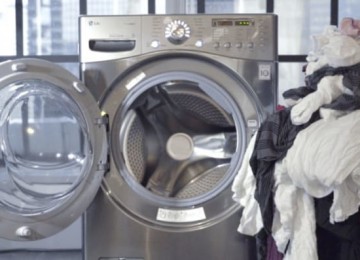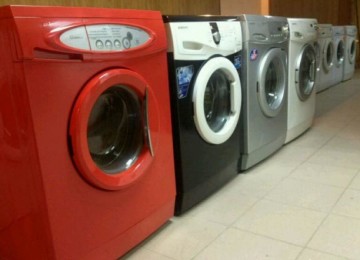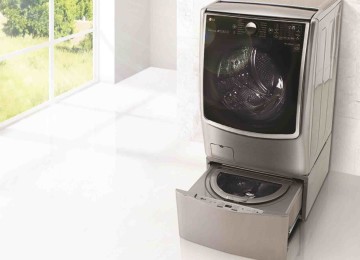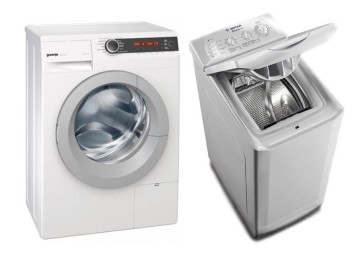Every modern housewife cannot imagine her life without an automatic washing machine. It saves time and effort, and the quality of washing exceeds all expectations. There are many devices on the household appliances market that differ in price and technical parameters. In order to choose the best option, you should consider energy consumption indicators, washing classes in washing machines and other parameters.
What is a washing class
To determine the performance of a washing machine and the degree to which items are cleaned after washing, a special criterion called a class has been developed. It helps to understand how effectively dirt is removed from items made from different types of fabrics. That is, it characterizes the quality of washing. In the process of classifying the technique, not only the type of fabric is taken into account, but also the origin of the stains, as well as the quality of the powder used.
The higher the class of the machine, the better it will clean laundry, in comparison with other analogues of a lower class under the same experimental conditions.Each class describes a specific efficiency index, which is assigned depending on the quality indicator. Numbering is carried out from the letter A to G.
The high class of the device is reflected in the final washing result, the cleanliness of things, and the reduction in resource consumption. However, the cost of household appliances does not always depend on it. As a rule, the price is influenced not only by class, but also by brand recognition. Thus, a well-known brand class B washing mashine can cost the same as a less advertised class A washing mashine.
The classification of the device is carried out after passing special tests and comparing the results obtained with reference values.
How is the washing class determined?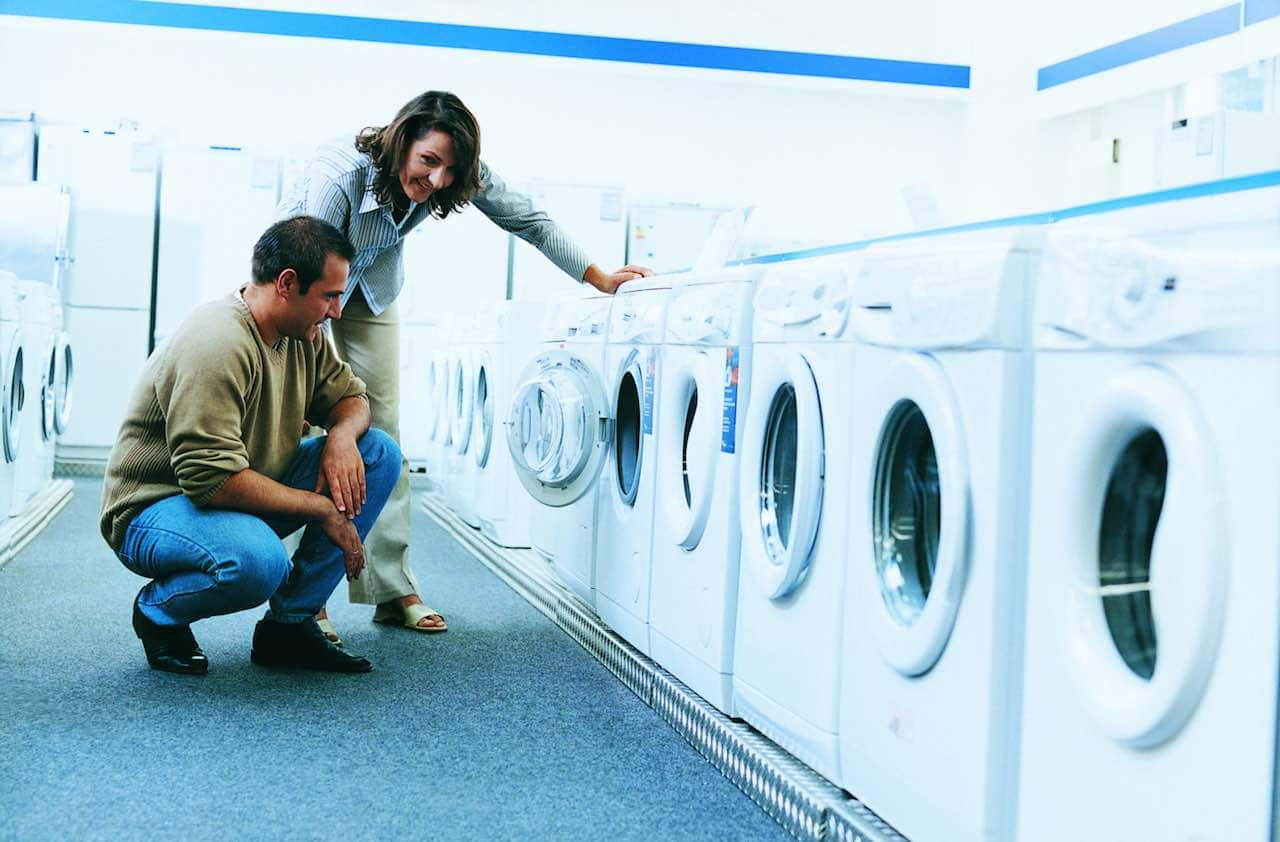
This parameter is determined at the stage of manufacturing the device by the manufacturer in accordance with developed standards. There is no way to test the equipment yourself at home. Therefore, you can check which class the purchased machine belongs to after reading the technical documentation of the unit. Testing technology consists of checking the quality of washing in a reference and tested machine. After the experiment, the results are compared.
An efficient washing machine is taken as a reference model, which shows stable, good results over 5 washing cycles. Such equipment was created in 1995, and is now present in many large enterprises that produce washing machines. The process consists of the following steps:
- The contaminated flaps are placed in the drum of the reference model. Loading weight is 5 kilograms.
- The reference washing program is set at 60 degrees.The duration of the process is 1 hour, and the amount of powder used is 180 grams.
- The process is completely repeated, but in this case the model being tested is used. All parameters are identical: type of contamination, type of fabric, time, quality and volume of powder used.
- The results are compared. Depending on the quality of cleaning, the equipment is assigned the appropriate class.
The spin class is determined as follows:
- The laundry removed from the drum after the wash cycle is weighed.
- After complete drying, the items are weighed again.
- The difference in weight between dry and wet items is determined. Depending on this value, the device is classified into one class or another.
The modern world is constantly improving, technology developers are working to improve equipment performance. Today, models are appearing that are superior to standard models in many respects. To designate such units, use the “+” sign. A+, A++ or A+++ means that the device being tested is much more efficient than the reference device; such units have the highest washing class.
Types of classes in the machine
7 main groups have been developed that determine the efficiency of the device, the quality of washing and spinning, as well as its energy consumption. The better the washing results, the higher the class of equipment. Let's take a closer look at the existing classes and analyze their characteristic features and parameters.
Washing classes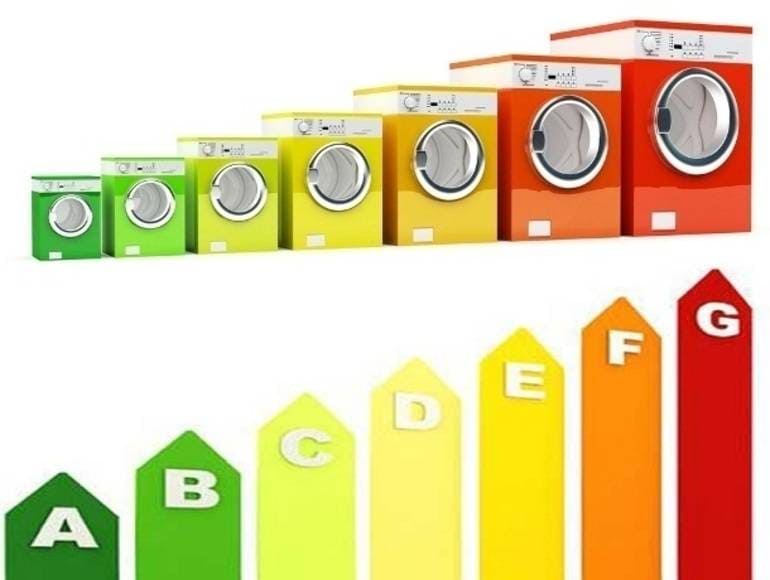
A
Such washing machines provide effective removal of all types of stains. This is an ideal solution as it ensures clean and fresh laundry. The quality factor is at least 1.03.This means that the machine copes with dirt slightly better than the reference model (1.03 times).
IN
They also have fairly good quality indicators; the coefficient of such specimens is in the range of 1-1.03. Washing quality is comparable to reference models.
WITH
The parameters of such models are lower. In particular, the quality factor is in the range of 0.97-1. However, this is also very good.
D
The washing quality of such washing machines is normal, the coefficient is 0.87-0.94.
E
The models are characterized by satisfactory performance, the quality index is in the range of 0.91-0.94.
F
The washing quality of these machines is poor, the coefficient is 0.88-0.91. That is, the machine practically does not wash off dirt.
G
Both models of this type and the previous one are practically never found, because any conscientious manufacturer will not allow the production of such copies. The performance of products of this class is characterized as very poor, the quality factor is unacceptable and amounts to 0.75-0.88. However, if you encounter a product of this type, you should not purchase it.
Spin classes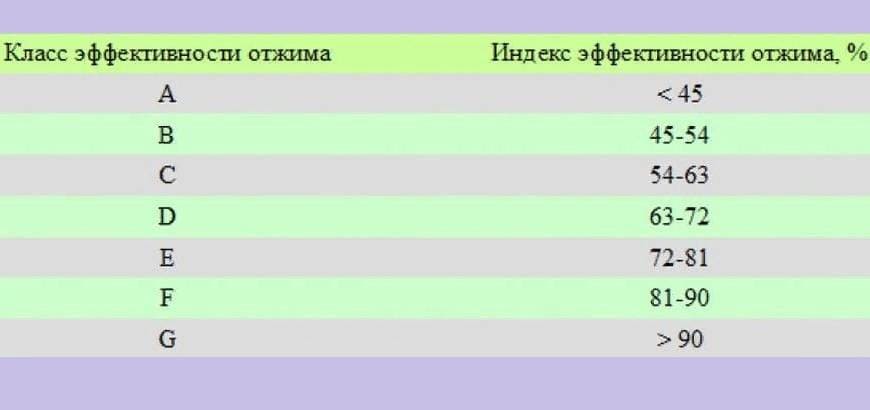
The spinning process is based on the action of centrifugal forces that “push” water out of the fabric. This process is characterized by a criterion called residual moisture. This is the amount of moisture remaining in the material at the end of the spin cycle. The dryness of the laundry depends on the rotation speed and volume of the drum, the throughput of the material and the duration of the process. The following classes are distinguished.
A
These models have the highest drum rotation ratio (more than 1500 rpm) and a spin ratio of less than 45%. Suitable for removing moisture from rough, dense materials.It should be noted that delicate tissues may not withstand such intensity of rotation. Therefore, if you wash mainly light fabrics, for example, underwear, lace, fine wool, it is better to choose a lower class option.
IN
The spin coefficient is 45-54%, the drum rotation speed is 1200-1500. Also a very strong level, suitable for terry fabrics. It should be noted that the first two classes of machines vibrate excessively during spinning, which is not always practical or convenient.
WITH
The amount of residual moisture in washed laundry is about 54-63%, speeds of about 1000-1200 are considered optimal for all types of fabrics, including coarse fabrics. Slightly damp laundry can be easily dried on a line. The main thing is that it will not tear as a result of spinning.
D
The spin ratio is 63-72%. The devices ensure rotation of the drum at a speed of 800-1000 rpm. This is the best option for most cotton and synthetic fabrics.
E
The parameter characterizing the quality of spin is in the range of 72-81%. Quite an intense effect on the fabric. The number of revolutions in the range from 600 to 800 is ideal for delicate fabrics.
F
Spin - 81-90% and number of revolutions - 400-600. This means that things remain wet after washing. Suitable for thin fabrics only.
G
The spin ratio is more than 90%, the rpm is less than 400. This is a very poor quality of the process; the machine will only spin very thin fabrics. In terms of the degree of spin, this type is comparable to manual.
Energy classes
It is quite easy to check the amount of energy consumed. To do this, you just need to run the standard washing cycle at 60 degrees for one hour.After the end of the cycle, the result is revealed. The machines are classified as follows.
A
Electricity consumption is about 0.17-0.19 kW per hour for every kilogram of laundry.
IN
Electricity consumption of models of this class is from 0.19 to 0.23 kWh/kg.
WITH
Products of this class consume about 0.23-0.27 kWh/kg.
D
Energy consumption – 0.27-0.31 kWh/kg.
E
The devices consume 0.31-0.35 kWh/kg.
F
Electricity consumption - 0.35-0.39 kWh/kg.
G
Electricity consumption – more than 0.39 kWh/kg.
The latter classes belong to the category of devices that consume a significant amount of electricity, while the quality of washing leaves much to be desired. The units practically do not remove stains, and the laundry remains wet after being removed from the drum.
Today, the energy consumption class designated A+ is considered the best option. These are very economical models, consuming less than 0.17 kWh/kg. Also, thanks to the developments of engineers, class A++ and A+++ models are produced. They allow you to save up to 30% of energy resources, resulting in significantly reduced costs. It is quite rare to find class B or C products on store shelves. Even the cheapest models are usually marked with the letter A.
Which class is recommended to choose?
The difference between the quality of work of class A, A+ and B models is almost impossible to see with the naked eye. It will become invisible if you use a good detergent. All models will efficiently remove dirt and freshen things. Still, experts recommend purchasing higher-class products, all other characteristics being equal. If you don’t want to overpay for class, the class B option is quite suitable.This is a good choice for solving everyday problems.
As for the spin class, the situation is different here. The fact is that the spin efficiency depends on the rotation speed of the drum. The faster it moves, the greater the energy consumption. Therefore, choosing a high-speed class A drum is justified if items made of predominantly heavy fabrics, such as denim, are loaded into it. Excessive mechanical stress on delicate fabrics such as silk and cashmere can cause them to deteriorate. Once removed from the drum, such things are difficult to straighten; creases appear on them that cannot be smoothed out even with an iron. For domestic needs, class B or C models are quite suitable.
In the technical documentation of modern models, instead of the energy consumption class, a new characteristic is used - the energy efficiency class. It is calculated based on the energy efficiency index, which is the ratio of the actual energy consumption of the test machine to the value of the reference model. The higher the class, the lower the index. The standard value for electricity consumption is 1.52 kWh. It is believed that the machine performs 220 cycles per year, then the annual consumption is 224 kWh. The drum can be loaded with dry laundry weighing 6 kg.
Purchasing washing equipment of the highest class is not always justified. If the owner does not have special requirements for saving resources or the equipment is not used intensively, then it is rational to purchase products of a lower class, for which you do not need to overpay.Well, and vice versa, if the machine is used very often, and the question of saving energy and water arises, then choosing a product of the highest class will be optimal.
What influences the choice of washing mashine class?
The question of choosing household appliances for the home worries everyone, but not everyone pays attention to important criteria. More often than not, buyers are guided only by financial capabilities. However, a serious and responsible client will definitely take into account the class of the device, on which the following indicators depend:
- Quality of washing and spinning. The final result is influenced by the speed of the drum. At minimum speeds, the material simply does not wash off, while at the same time, too high a rotation speed will lead to the fact that the item will simply tear. Of course, when determining this parameter, the density of the fabric should be taken into account.
- Electricity consumption. Low-end products consume a significant amount of energy.
- Time spent doing laundry. The drum rotating at high speeds saves time, as cleaning occurs faster. It also depends on the program installed, since it is this that determines the duration of each washing cycle.
- The volume of laundry washed at one time. If the efficiency of the device is low, then it is not possible to load a large number of things.
- Financial expenses. By purchasing a high-end machine, we ensure resource savings, which will be noticeable during further use. Low-end appliances cost significantly less than their high-end counterparts, so the choice of one or another model is determined by the frequency of use of household appliances and other considerations.
How to choose a washing machine according to the above characteristics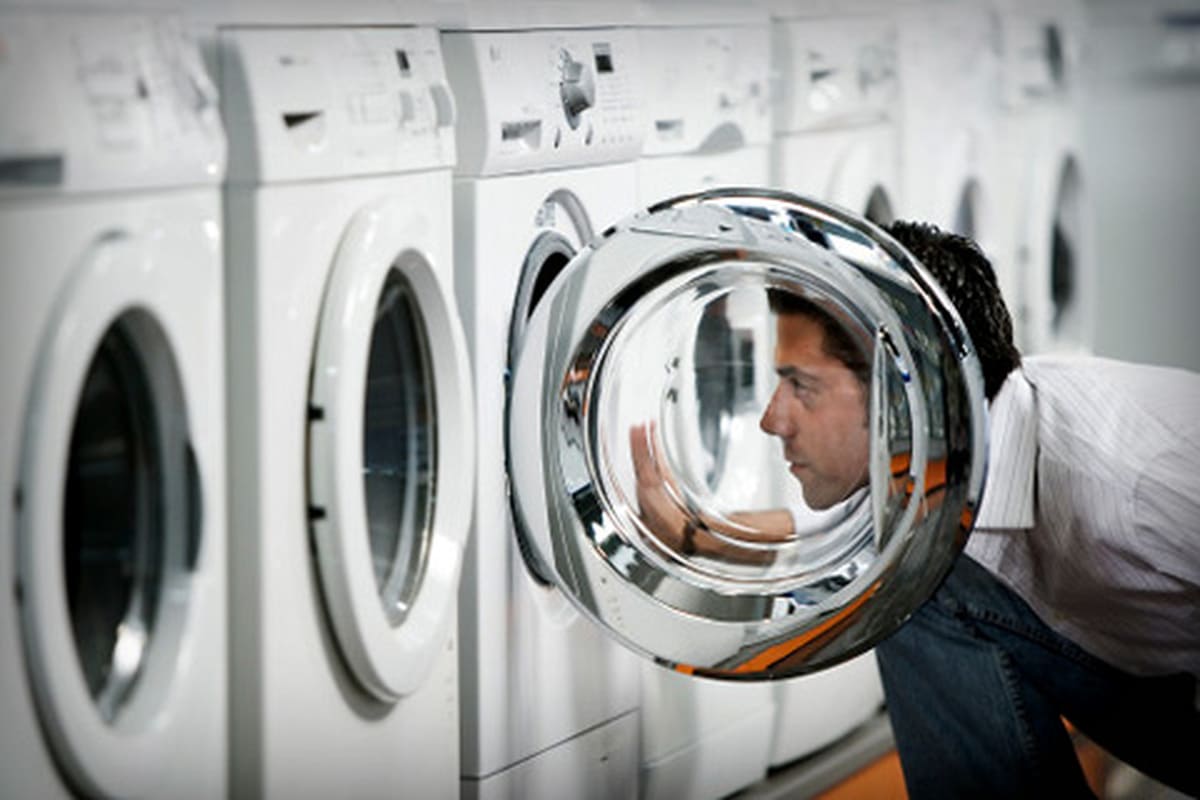
When choosing a household appliance, it is advisable to take into account each of the listed parameters: washing and spinning class, energy consumption. A device with the highest possible indicators will provide excellent cleaning of fabric from stains and good spinning, so the items removed from the drum will be clean and semi-dry. At the same time, the costs for electricity and water will be minimal. However, experts recommend paying attention to budget options that will cope with household tasks and allow the buyer to remain a winner.
It is not so easy to choose a universal machine: each model has some advantages and disadvantages. It is better to choose the best option depending on the specific type of laundry: thick, delicate, durable, rough, light. In some cases, it is more advisable to prefer class B and C models, which provide gentle spinning of textiles. As already mentioned, a class A automatic machine can harm the washed items, since they are excessively exposed to stress and twisting. Is this really justified? 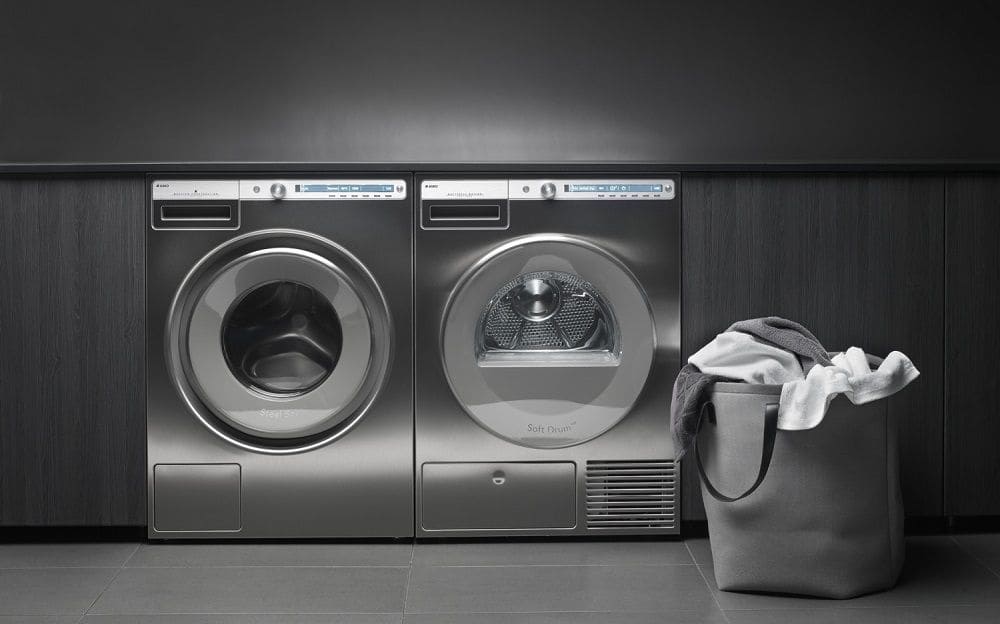
High-class washing machines are an order of magnitude higher than their conventional counterparts. However, the overpayment covers future costs for the resources used: electricity and water. Such savings will be especially noticeable if the machine is used very often. That is why it is necessary to compare the costs of purchasing the equipment with the potential savings that the device will provide during operation over the next few years. To do this, you can calculate how many hours a week the machine works. Then determine the kilowatts that can be saved during the year.It is not always advisable to overpay several thousand for a high-class machine, since without special equipment the difference between class A and B models is almost impossible to see: in both cases, stains are effectively removed. There is no point in chasing advantages if it entails additional costs.
Before choosing a suitable device, be guided by the following criteria:
- the amount expected to be spent on the purchase:
- compliance of the washing and spin class with real needs (class B and C options are quite suitable for home use);
- energy consumption, currently the most popular models are class A+ and higher;
- volume of things to put into the drum - for large families, options with a larger drum diameter are preferable;
- time required for washing.
The letter designations of the class are indicated on a special sticker; it is almost always present on the body of the machine. This usually reflects the energy consumption class calculated for one kilogram of laundry. It is very easy to determine how much electricity a machine will consume at maximum load. To do this, you just need to multiply this parameter by the weight of the laundry. If there are no markings on the case, you shouldn’t be upset. Manufacturers do not usually label equipment in this way that is not intended for sale in the European Union. This in no way indicates the low quality of the product. Knowing the technical characteristics of the device and its parameters, you can easily choose the appropriate model.
The correct choice of household appliances is the key to rational and careful use of funds. Properly selected equipment will last a long time, save resources, and ensure convenient and reliable operation.Experts recommend choosing expensive models with a large number of modes only if they will actually be used. For most families, reliable, high-quality units without complex programs with a high energy efficiency class are quite suitable.






